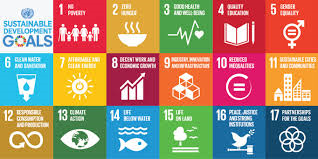The SDGs build on the success of the Millennium Development Goals (MDGs) and aim to go further to end all forms of poverty. The new Goals are unique in that they call for action by all countries, poor, rich and middle-income to promote prosperity while protecting the planet. They recognize that ending poverty must go hand-in-hand with strategies that build economic growth and addresses a range of social needs including education, health, social protection, and job opportunities, while tackling climate change and environmental protection.
While the SDGs are not legally binding, governments are expected to take ownership and establish national frameworks for the achievement of the 17 Goals. The 17 Sustainable Development Goals and 169 targets of the new agenda will be monitored and reviewed using a set of global indicators.
These are the 17 goals:
- End poverty in all its forms everywhere;
End hunger, achieve food security and improved nutrition and promote sustainable agriculture;
Ensure healthy lives and promote well-being for all at all ages;
Ensure inclusive and quality education for all and promote lifelong learning;
Achieve gender equality and empower all women and girls;
Ensure access to water and sanitation for all;
Ensure access to affordable, reliable, sustainable and modern energy for all;
Promote inclusive and sustainable economic growth, employment and decent work for all;
Build resilient infrastructure, promote sustainable industrialization and foster innovation;
Reduce inequality within and among countries;
Make cities inclusive, safe, resilient and sustainable;
Ensure sustainable consumption and production patterns;
Take urgent action to combat climate change and its impacts;
Conserve and sustainably use the oceans, seas and marine resources;
Sustainably manage forests, combat desertification, halt and reverse land degradation, halt biodiversity loss;
Promote just, peaceful and inclusive societies.
Revitalize the global partnership for sustainable development
For each goal, a number of facts and figures are provided; and for each goal, a number of tangible targets are defined.
These are the targets for goal 4, related to education:
- By 2030, ensure that all girls and boys complete free, equitable and quality primary and secondary education leading to relevant and Goal-4 effective learning outcomes;
By 2030, ensure that all girls and boys have access to quality early childhood development, care and pre-primary education so that they are ready for primary education;
By 2030, ensure equal access for all women and men to affordable and quality technical, vocational and tertiary education, including university;
By 2030, substantially increase the number of youth and adults who have relevant skills, including technical and vocational skills, for employment, decent jobs and entrepreneurship;
By 2030, eliminate gender disparities in education and ensure equal access to all levels of education and vocational training for the vulnerable, including persons with disabilities, indigenous peoples and children in vulnerable situations;
By 2030, ensure that all youth and a substantial proportion of adults, both men and women, achieve literacy and numeracy;
By 2030, ensure that all learners acquire the knowledge and skills needed to promote sustainable development, including, among others, through education for sustainable development and sustainable lifestyles, human rights, gender equality, promotion of a culture of peace and non-violence, global citizenship and appreciation of cultural diversity and of culture’s contribution to sustainable development;
Build and upgrade education facilities that are child, disability and gender sensitive and provide safe, nonviolent, inclusive and effective learning environments for all;
By 2030, substantially expand globally the number of scholarships available to developing countries, in particular least developed countries, small island developing States and African countries, for enrolment in higher education, including vocational training and information and communications technology, technical, engineering and scientific programmes, in developed countries and other developing countries;
By 2030, substantially increase the supply of qualified teachers, including through international cooperation for teacher training in developing countries, especially least developed countries and small island developing states.
